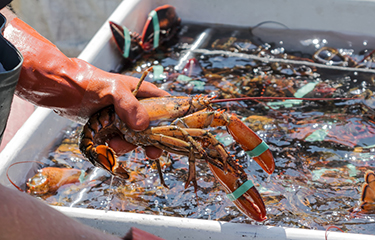Maine’s lobster exports to China plunge 84 percent due to trade war

The latest data from the Maine International Trade Center indicates that the state’s lobster exports to China plunged dramatically in the wake of retaliatory tariffs placed on a wide range of U.S. goods.
The tariffs, implemented in July 2018, had an immediate affect on the state’s lobster industry. Prior to the tariffs, Maine had been on track to have a record-setting year, with USD 87 million (EUR 77.8 million) worth of lobster exported through June 2018, over double the USD 42 million (EUR 37.5 million) shipped through the same period in 2017.
Soon after tariffs were implemented, however, Maine’s exports to China nearly disappeared completely, and according to the latest data from the MITC exports have plunged nearly 84 percent since the tariffs were implemented.
The latest talk on the trade front doesn’t point to any improvement in those numbers any time soon. U.S. President Donald Trump threatened and then implemented further tariff increases on 10 May. In response, China fired back with its own increased tariffs, including additional tariffs on a number of seafood products.
Despite the threat of escalation, for many lobster exporters, the damage has already been done. Whether the tariffs increase or not, most of the business had already dried up.
“Retaliatory tariffs, or a move upward to 25 percent, doesn’t really change anything for U.S. exporters to mainland China,” Sheila Adams, the vice president of sales and marketing for Maine Coast Lobster, told SeafoodSource.
Maine Coast’s owner Tom Adams said in September 2018 that the company’s exports to China had all but vanished in the wake of tariffs.
“We did fine right up to the beginning of July, we were on track for normal revenue into China,” Tom Adams said. “We already had the European tariff, so our European sales were down a little bit, but we were maintaining our revenue, similar to 2017. And then the [Chinese] tariff came.”
Since then, the news hasn’t improved.
“It has sustained that, it's been pretty much the same,” Sheila Adams said. “If we do business into mainland China, it tends to be very opportunistic, based on supply and demand. It’s gone from very regular large-scale relationships, to very opportunistic.”
For U.S. lobster exporters, during the Trump administration, the number of other markets that Maine can compete on a fair basis with Canadian exporters of lobster has shrunk. The Comprehensive Economic and Trade Agreement, a trade deal between the European Union and Canada, has put Maine's lobster sector at a disadvantage to its Canadian counterparts.
Still, despite the uphill battle it faces China and Europe, the Maine lobster industry still had a good year in 2018, with a valuation of over USD 484 million (EUR 433 million), more than USD 46 million (EUR 41 million) higher than in 2017.
Lobster represents the largest export for the state of Maine by value. According to the U.S. census, the state exported USD 386 million (EUR 345 million) worth of lobster in 2018, representing 13.7 percent of the value of exports from the state. That was an increase from USD 325 million (EUR 290 million) in 2017, showing the industry has found other markets for their product.
A lot of Maine Coast's exports, Sheila Adams said, are going to new markets where the company has managed to develop relationships. That has allowed Maine Coast to meet their financial expectations for 2018.
“We’re really proud of the fact that we exited the year on target,” she said. “We just had to find other markets.”
Whether the trade war will end any time soon is out of their control, Sheila said, so it’s a matter of waiting. Plus, if and when the trade relationships with China and Canada return to a more even playing field, the company expects to be able to grow even further.
“We control what we can control,” she said. “We really believe that this will resolve and it's just going to be added growth to us now.”






Share